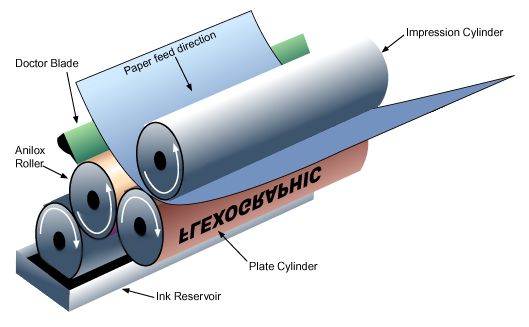Flexographic printing
Flexographic presses are capable of producing good quality impressions on many different substrates and is the least expensive and simplest of the printing processes used for decorating and packaging printing. The use of flexographic printing presses is on the rise. There are two primary reasons for this: 1) it is a relatively simple operation; and 2) it is easily adapted to the use of water-based inks. The widespread use of water-based inks in flexographic printing means a large reduction in VOC emission compared to the heatset web or gravure printing processes.
Publication flexography is used mainly in the production of newspaper, comics, directories, newspaper inserts, and catalogs. Packaging flexography is used for the production of folding cartons, labels, and packaging materials. Large quantities of inks are used during normal runs on flexographic presses; however, some printers are able to recycle a majority of their spent inks and wash waters. Major chemicals used in flexography include platemaking solution, water and solvent based inks, and blanket/roller cleaning solvents.
Flexography is a form of rotary web letterpress, combining features of both letterpress and rotogravure printing, using relief plates comprised of flexible rubber or photopolymer plates and fast drying, low viscosity solvent, water-based or UV curable inks fed from an "anilox" or two roller inking system. The flexible (rubber or photopolymer) plates are mounted onto the printing cylinder with double-faced adhesive. Plates are sometimes backed with thin metal sheets and attached to the cylinder with fastening straps for close register or ink alignment. This adds additional cost to the plate and requires more makeready time, but when quality printing is critical this type of plate can make the difference.


These days YouTube recordings quality is all the more better and enhanced, so that is the cause that I am watching this video at this spot.
ReplyDeleteDesoxidantes Inhibidores de Corrosion